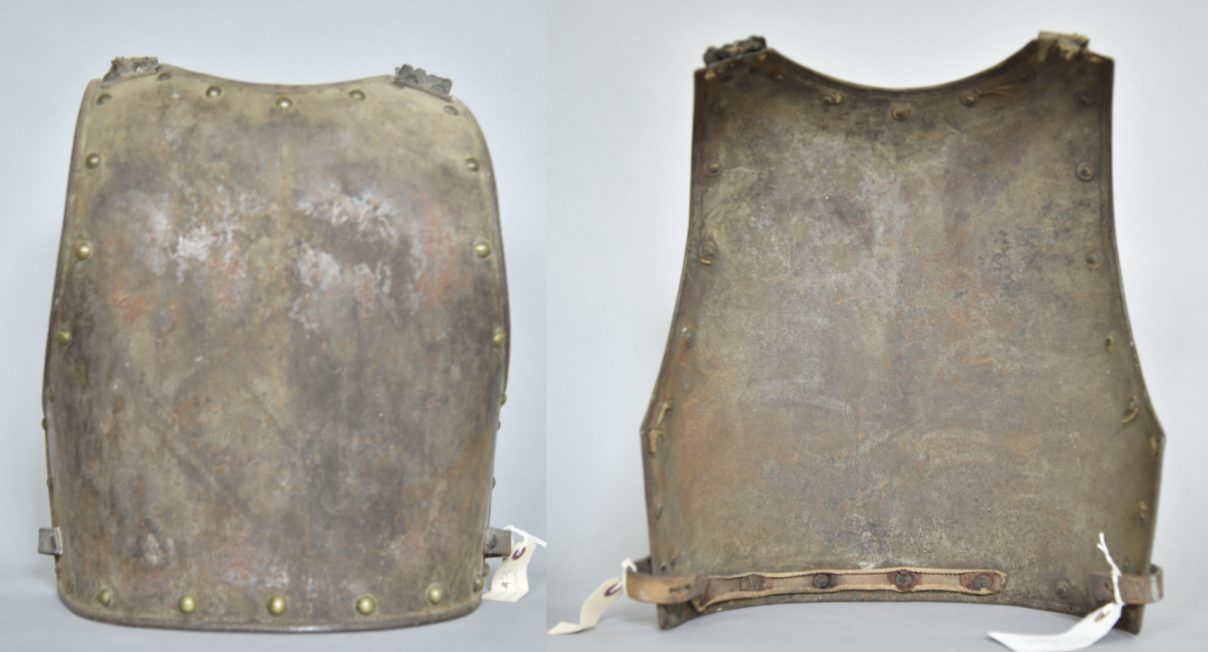Backplate
Object

The object is a 19th Century backplate which forms part of Kiplin Hall’s collections in North Yorkshire. The backplate was acquired by Kiplin Hall Trust in 1971 from Bridget Talbot, the Hall’s last familial owner, and it was noted in a basic inventory in 1972. It was later properly accessioned in 1992 along with the rest of the collection amassed over the Hall’s 400-year history.

The current inventory lists the backplate as ‘18th century’. However, comparison of the matching breastplate revealed the pair to closely resemble the uniform of Major General the Hon. Sir Reginald Talbot (1841-1929) from a photo found within Kiplin Hall’s 2013 exhibit titled ‘Duty Calls’, detailing the history of conflict that the residents of the Hall took part in.
Major General the Hon. Sir Reginald Talbot was the uncle of Bridget Talbot and a member of the 1st Regiment of Life Guards in the 19th century. Born 11th July 1841 in London, Reginald Talbot entered the army as sub-lieutenant, 1st Regiment of Life Guards, in 1859 aged 17/18. He was promoted to colonel in 1885 and commanded his unit from 1885-86. In 1898 he became a major-general before leaving active service in 1903. Talbot saw notable action in the Zulu War of 1879 and the Egyptian conflicts of the 1880s over the Suez Canal where he notably had his horse shot beneath him in Kassassin.

The Life Guards are the most senior regiment of the British Army and are one of two cavalry regiments which make the Household Cavalry, a part of the household division. Today they are tasked with many ceremonial functions including the guarding of the monarch.
The 1st Regiment of Life Guards was formed in 1788, though can be traced back to its founding as ‘His Majesty’s Own Troop of Horse Guards’ in 1658, and remained until 1922 when the 1st and 2nd regiments were merged into the modern-day Life Guards.
Condition
- There is a layer of dirt and dust on the surface of the backplate
- The iron displays evidence of active corrosion on the surface
- The brass components have tarnished
- The leather shows signs of fraying and loss from delamination
- The textile appears to be fraying at the edges.
Conservation

The steel surface of the backplate was initially cleaned with ethanol and a microfibre cloth to remove the dust and dirt which had accumulated in storage before the task of removing the corrosion products was attempted. To remove the iron corrosion products the surface was mechanically cleaned using a very fine abrasive product with a lubricant to minimise the risk of scratching.
Similarly, to the steel, initial dust and dirt was removed from the brass components with ethanol. Due to brass being a soft metal and easily scratched, a low abrasive cleaning product was used to remove the tarnish. This proved successful for the majority of the brass. However, the fish scale plates were extremely tarnished and due to their proximity to the leather, not much pressure could be used. A slightly more abrasive cleaning product was used on these areas, which proved successful at removing tarnish.

The leather fragments proved too fragile for most mechanical cleaning. As such, wet cleaning using a suitable gel was used with some success. Once cleaned the condition of the leather was easier to ascertain revealing that the majority of the leather was stable and did not require consolidation. The fraying edges of the leather fragments were still a cause for concern so were consolidated to prevent further deterioration.
The textile fragments were wet cleaned to remove surface dirt, then were soaked with the same cleaning solution so they could be flattened. A layer of microfibre cloth was laid over the damp, flattened fragments and sandbags were applied to the surface to hold them in place while the textil dried. The fraying edges of the textile were then consolidated in order to prevent further deterioration.
